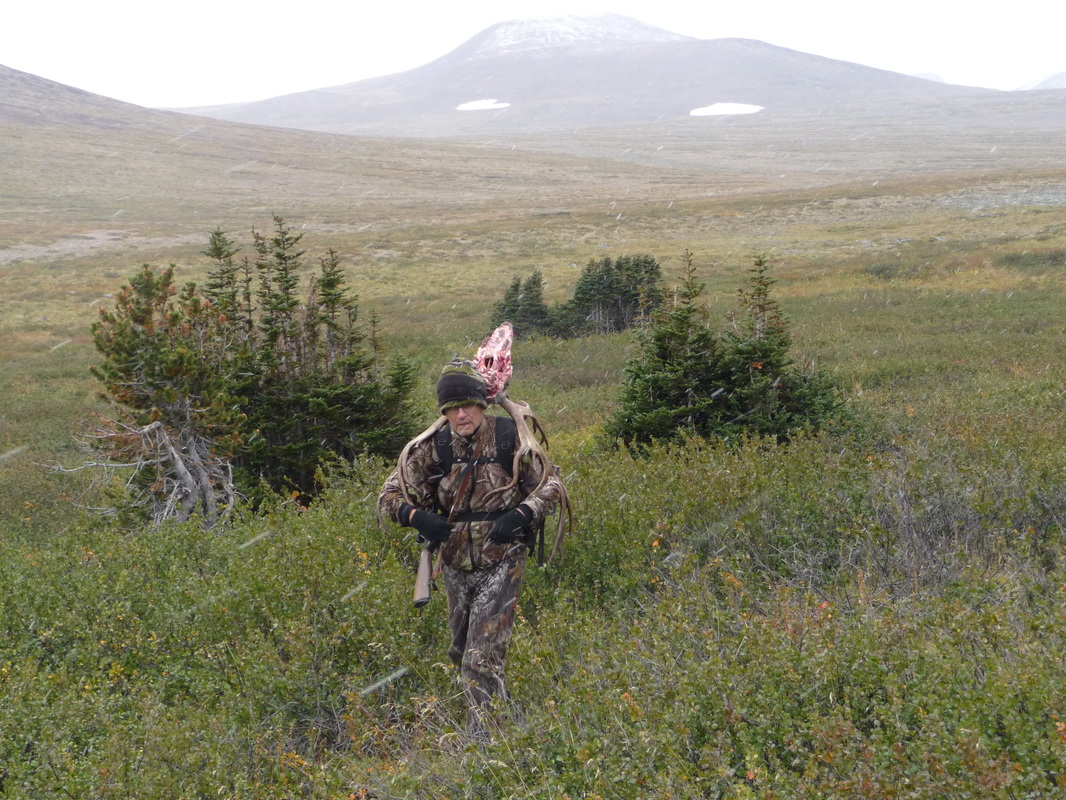During every wilderness journey there is a moment when we depart one world for another, when the grasp of the cell signal slips away and we trade the reality of calendars, convenience and modernity for simple tools and primitive pursuits. This year that time warp occurred in a short step from a wooden dock to the aluminum float of a bush plane – an 18” stride over a gap of lake water slick with the drippings of the freshly fuelled Cessna that would transport us from one world to another.
It was mid-September and my father and I were embarking on our semi-annual fly-in hunt, this year for caribou. We liked to believe that we had timed the hunt to occur before the start of the rut when the meat is best or before the lakes froze over, but the reality was that kid’s birthday parties and work deadlines had as much to say in the matter. Civilization does not loosen her clutches easily.

As a dirty smudge on the horizon slowly sharpens into our destination mountain range, the landscape I have been studying two dimensionally in previous months is drawn into sharp relief, a carefully laid out blanket pulled into ridges, gullies, plateaus and peaks. We wing our way over valleys trenching their way through the loose rock of the upland. The caribou have chosen their hiding places well, and we must continue to rely on the hunter’s undying optimism that the animals will be there.
The lake appears to shimmer, and suddenly we have touched down, taxiing up to the gravel beach that marks our point of arrival. The shoreline is a palisade of jack pine, their unrelenting verticality broken only by the occasional meat pole lashed between two trees. The float crunches on the gravel beach, bags are unloaded (not forgetting the white gas!) and we say our good byes and good lucks. We push the tin can from the beach, then watch the Cessna lumber down the lake, reluctantly pulling its floats from the clutches of the water and disappear with a faint hum.
The silence is deafening and we sit on our bags letting it sink in. For those of us who make our living in the city, this is our annual treatment, our self-prescribed tonic to the reality of crowds, money, vehicles and buildings. In this place the currency is sweat, the cars replaced with two legs and a strong back, and the buildings reduced to a nylon tent fly. For the next week we are engaged not in the translation of work into wealth, but in one of the most primal pursuits known to man. Occasionally we are told that what we do is barbaric, or primitive, which is probably true, but all of us know what it is like as children to want to chase, to pursue, and there is something deeply human about running after wild animals that is not learned or acquired, but exists within us. As equally ingrained in our nature is the profound sadness that follows the pulling of a trigger and the tremor in our hands as we watch life leave an animal’s body. “We do not hunt to kill, but we kill to have hunted” (Jose y Ortega).
Beyond the clean nourishment they provide, these animals allow us to be part of the wild places in ways a non-hunter will never experience. In the hunter’s world we are not casual observers in a series of carefully protected landscapes, but rather active participants in the ebb and flow of the ecological circle of life.
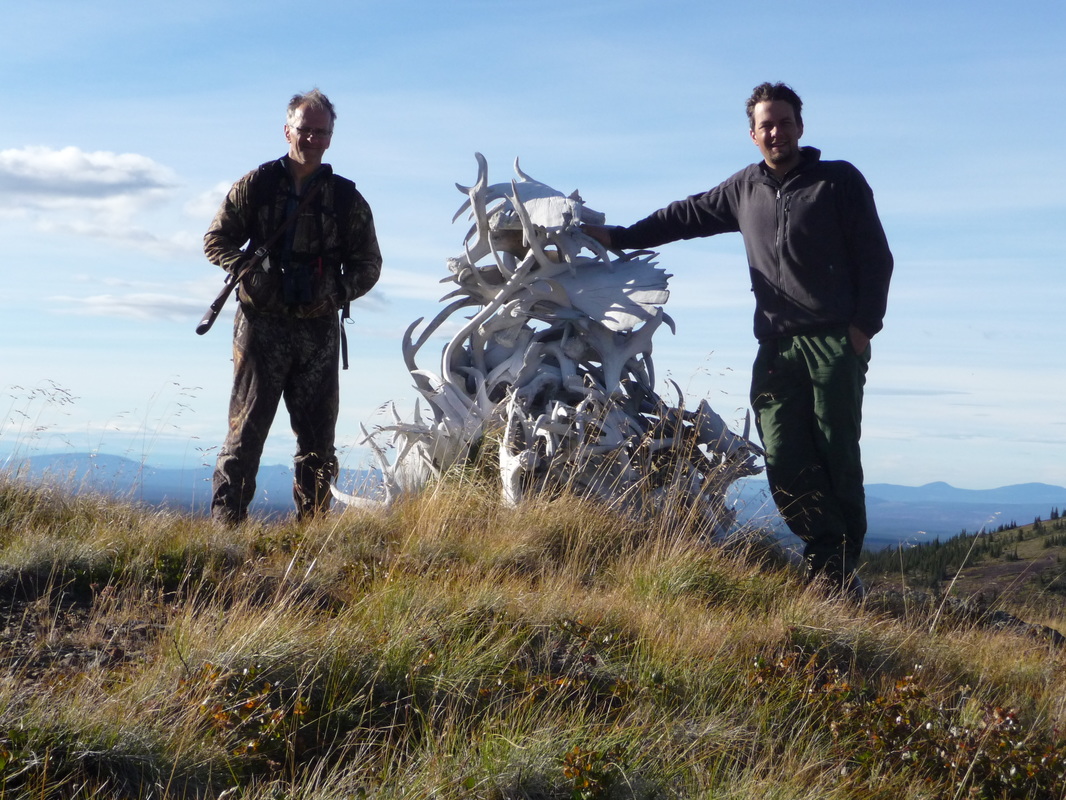
After a fitful night adjusting to new, yet old and familiar sounds, we awake. The hissing stove produces two cups of dark coffee, that elixir of life that always prompts a trip to the nearest deadfall. We choke down a cup of porridge, if only by sheer determination and an eagerness to hit tree line. We assemble the packs that will take us into the alpine for the next few days, and our boots, the leather slowly softening, find the trail. These are the happiest days of the hunt, still punch drunk on pure anticipation, every fibre twitching to get to the nearest glassing point and catch the first glimpse of hair in the scope. It’s a feeling so palpable you can taste it.
After two hours of single track, the trees begin to thin out and the pine gives way to spruce. The flanks of this volcanic range begin to show themselves, their ochre hides revealed between the clumps of krummholz. In a fold carefully drawn in the landscape, a creek flows and it is here, just below tree line at 6,000 feet that we set up our spike camp.
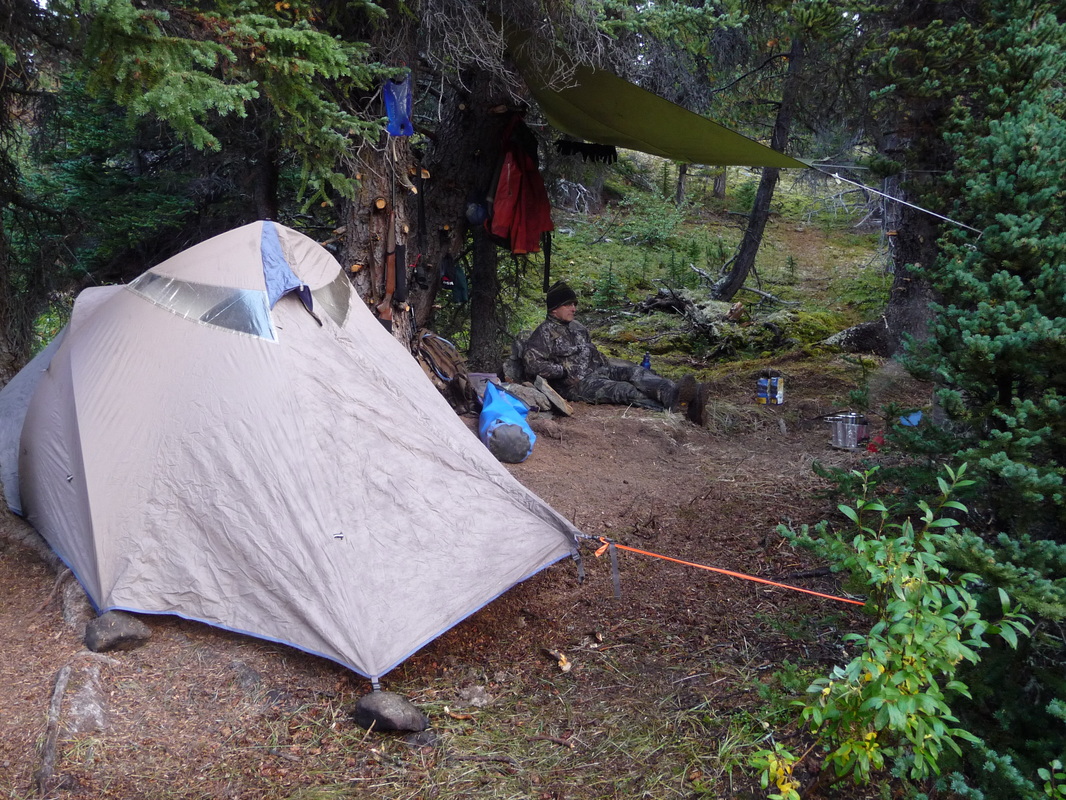
We love all these things because to us they mean a warm, dry place at the end of a day long beating delivered by sun, wind, snow and rain. A place where a scalding cup of black coffee will be brewed beneath a tarp winging overhead and a good book sits tucked in the folds of down sleeping bags. We love even the idea of these things because we know there is no place we would rather be.
Camp established, we shoulder much lighter packs and head out on a reconnaissance mission. The trail takes us past an established cairn of shed antlers, a pile of bone higher than a man’s head that tells us that we have found the wintering grounds of both the caribou and the moose. The trail winds its way up the crest of a final hill and finally spits us over the edge of the plateau, where we are immediately kicked in the teeth by a wind that pulls the tears from our eyes. We scurry for cover, finding it behind a twisted mat of tangled spruce. From here we pull out our binoculars and begin our surveillance. The plateau is a tilted plate, bisected by dry creek beds and ringed by bare shouldered volcanic remnants that were largely treeless. We could see the ragged edge of the tree line below us and knew that the animals would be tucked into these edges and in folds, and that the first move was up to them if we were to see them. Our first gaze revealed six mountain goats being chased by the slow edge of the shadow line around the mountain across from us. Beyond the goats, the plateau was empty. After several hours we headed back, eager to gain the comfort of a warm fire and a bag of re-hydrated mush. Small comforts, but appreciated nonetheless.
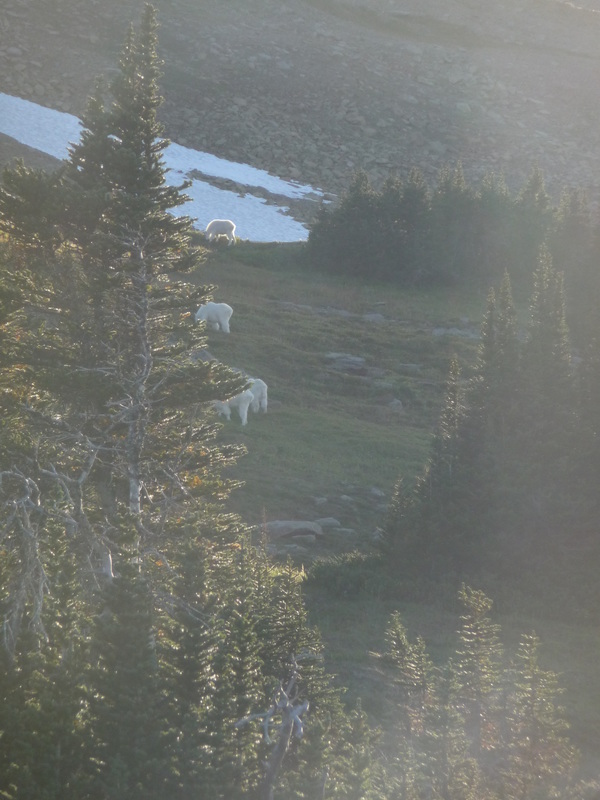
The tracks showed us that the caribou moved through old creek beds that formed slight, linear depressions across the plateau. These shallow depressions afforded the only continuous protective cover on the plateau and we studied them carefully. Still, the caribou kept themselves hidden. Our fading optimism was replaced by the growing doubt that we had somehow missed the primary herd. Each evening we convinced ourselves that we hadn’t quite searched the whole plateau – we had missed something and it was worth having another look in the morning.
Someone once told me that 90% of hunters are unsuccessful because they lose the mental battle and on the morning of the fifth day we knew this to be true. The doubt that had set-in drove us to question whether we would ever see another caribou and the feeling sat heavy in our stomachs. Still we rose, and, as they had on all other mornings, the goats taunted us from the heights of their unassailable ridge. You tell me that it’s not such a big deal to go home without a caribou, that I’m not from the Stone Age and that I’ll survive with store beef. That’s not how it works. There is a part of us that is only satisfied when we have finished our task and it is this part that suffers when the animals are scarce.
On this high, barren plateau the wind was a constant presence. With a cold, grey hand it swept the land clean of anything not fixed to the earth. The krummholz huddled together in clumps for protection, pockets of bunchgrass bent their tops losing the odd straggler to the gale and the solitary granite boulders hunched their lichen clad shoulders bitterly into the teeth of the wind. The mountains themselves showed their graying flanks, worn bare by the constant river of air that ground its way tirelessly over the landscape. It stole the words from our mouths, the warmth from our bodies and sent us scurrying for cover. Those of us not equipped to withstand the current of this terrific wind, existed in its back eddies. Together with the red columbines and the ground squirrels we tucked ourselves into the lee of the rock or behind a fold in the earth. Here the sun could reach us and we could lift our glasses to survey this remote kingdom of air, red earth, bent tree and pale sky. In this small space all was right with the world. All was right with the world, that is, except for the missing caribou.
The caribou were only missing for so long…
Then suddenly, there he was. Amidst a bachelor group of three bulls, his white mane marked him clearly in the landscape. They moved constantly, about 500 yards distant and parallel to us, making short work of the wide open space. The adrenaline that hits your system when you are suddenly thrust into the game is overwhelming. My Dad and I looked at each other, our grins quickly giving way to discussions about how we were to intercept the bulls. A quick glance through the binoculars spiked the blood pressure up to a whole new level, revealing the white-maned bull with heavy beams and a twisted mass of points. He was legal and he was something to watch, a real head turner. Extending the tangent of their travel, we realized that there was only one point of cover between the bulls and the next open basin they were lined out for, a point they were quickly approaching. Once past that poiTnt, there was nothing we could do but watch them disappear. This would not be a careful, precisely executed stalk. This was a flat out race!
Throwing our packs on, we ducked at the waist and ran tree to tree. Each time we stopped to catch our breath, I readied another piece of equipment- remove the gloves, check…take off the scope covers, check…chamber a round, check…get the rangefinder out, check. Each time we stopped, I told myself, “Don’t miss, take your time, count the points again, for good measure.”
We caught glimpses of the three bulls between the krummholz we kept between us and they were winning the race, slowly pulling away for the open space. We doubled our pace and went straight at them.
Then, 80 yards distant, the white-maned bull appeared, staring as we stumbled to a halt in full view. We dropped to our knees, our packs in front of us to help the rifle clear the willow. The pre-conditioning worked and I remembered the binoculars, the quick check on the antler points and then the rifle came up, settling in to that familiar spot on my shoulder. The safety came off and then nothing in the world mattered but the straight line that connected my eye, the crosshairs and the crease behind the bull’s shoulder. He stiffened, tensed and then collapsed. My barrel lifted and my hand worked the bolt, chambering the next round, but none of that mattered, my eyes were on the bull. He lay still in the willows and we, too, sank to the ground. This is the moment in which hunting becomes deeply human. When, in the pull of a trigger you are overcome by success, and crushed by the taking of life. We shared that moment together, father and son, hunters together, and let the sound of the wind, strangely absent during our pursuit, push the ringing remnants of the single gunshot out of our heads. The smell of gunpowder, crushed willow and spruce hung heavy in the air. We sat there, still 80 yards from our bull, as the pent-up emotion of the last five days slowly dissipated. The wind, previously so hostile, seemed strangely manageable now that we had wrestled our prize from the grips of this wild place.
The two younger bulls held up several hundred yards away, their velvet wrapped antlers tracing nervously against the grey sky. We watched them and then, shoulder to shoulder, we walked up to our bull. Even in death he was magnificent. His great head crowned with a heavy frame, his long white mane blowing in the wind. He lay there and we sank to the ground and sat there with him, overcome with gratitude and said our thanks.
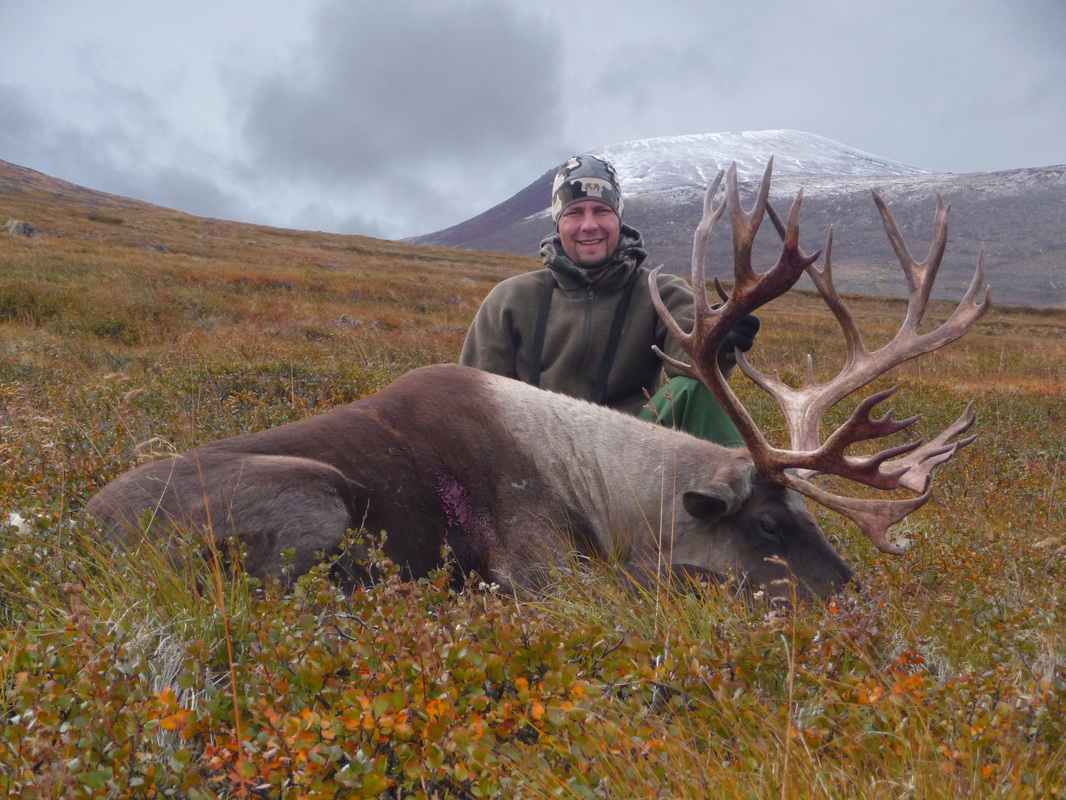 We broke him down carefully, laying the quarters on bits of hide stretched over the willows. Then we loaded a hind quarter each into our packs, and strapped the rack to the top of mine. There was a horse trail back to camp, but it took a while to find it, hidden amongst the carpet of buck brush. As we found our way back, it began to snow, the wind pulling apart the banks of woolly cloud over the plateau. We passed the cairn, and then it was down the final ridge to timberline. We hung the quarters from a pole lashed between two spruce trees as high as we could get it, knowing that it was more of a token gesture as far as bears were concerned. Heading back to the tent, we watched the sun chase the goats around the mountain again as it set. We slept well that night.
We broke him down carefully, laying the quarters on bits of hide stretched over the willows. Then we loaded a hind quarter each into our packs, and strapped the rack to the top of mine. There was a horse trail back to camp, but it took a while to find it, hidden amongst the carpet of buck brush. As we found our way back, it began to snow, the wind pulling apart the banks of woolly cloud over the plateau. We passed the cairn, and then it was down the final ridge to timberline. We hung the quarters from a pole lashed between two spruce trees as high as we could get it, knowing that it was more of a token gesture as far as bears were concerned. Heading back to the tent, we watched the sun chase the goats around the mountain again as it set. We slept well that night.
The next morning we returned for the rest of the meat and then ferried a load back down to base camp, returning back to the spike tent the same day. We had one tag left and one more look through the basin was too hard to resist. We woke early the next day, chased onto the trail by the season’s first frost which kept us from lingering over our coffee. We found a knob on the edge of the plateau that afforded shelter and a view of the kill site and it was from here that we saw the grizzly that had claimed the caribou’s remnants. His silver hide shook as he tore and ripped. Overhead the ravens wheeled, shards of black that caught the low, slanting light of the sun.
Several pairs of cows and calves showed themselves that day, but the bulls where nowhere to be seen, and after a day wandering the ridge lines we headed back. The goats near camp had moved lower, and we put the full sneak on them, closing in to within 40 yards. Backlit against the setting sun, they appeared as glowing white apparitions, strangers in a landscape of muted tones. We said our goodbyes and headed back for one more night at tree-line.
On that last day we collected the rest of the meat from the game pole and rigged our packs, quietly satisfied with their inhumane weight, and then settled in for the walk back. From caribou to the lake was well over eight kilometres and we would earn our meat. Having safely stashed the meat on a high pole at the lake shore, we returned to our base camp to pack up the rest of our gear. That evening, all our gear and meat down by the lake, we climbed a small hill near camp to look for moose. The low country that ringed the high plateau was dotted with small pothole lakes, swamps and willow browse. It was an area that should have been extremely rich in moose, but during the duration of our trip we had yet to see a single one, confirmation perhaps that the wolf population was indeed on the rise.
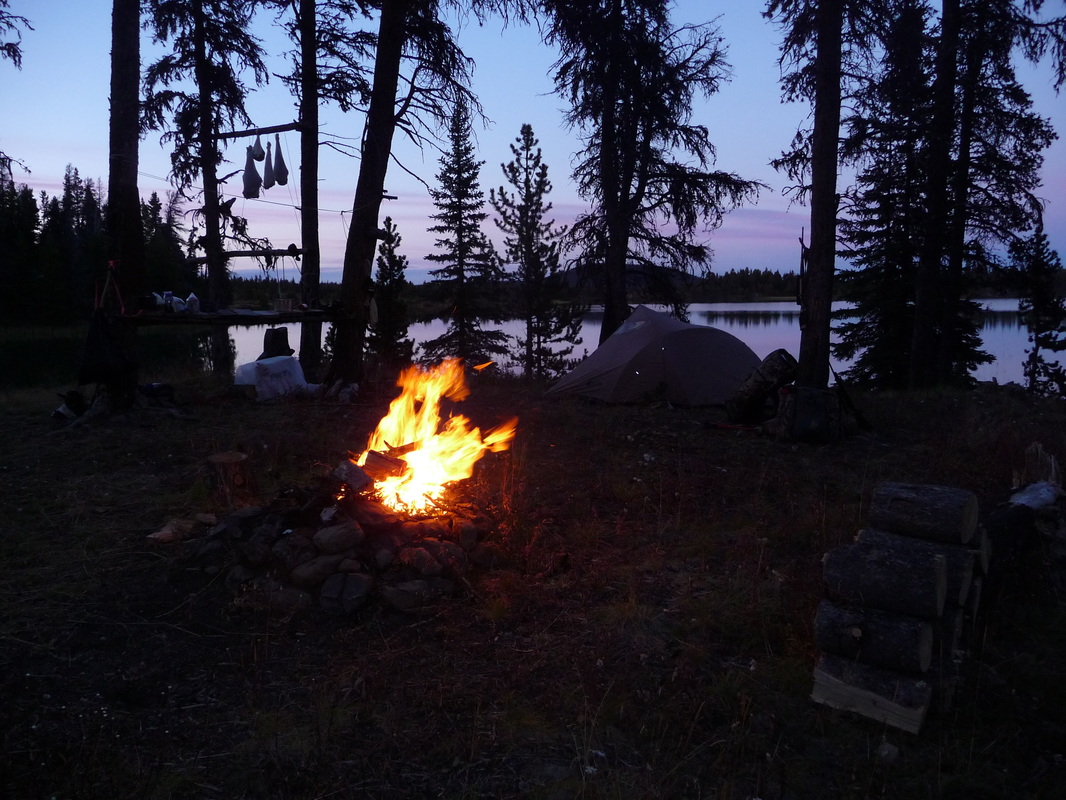
The next morning the Douglas squirrels had us up early and the rising trout in the lake put serious doubt in our minds as to why we hadn’t packed the fishing rods. Before long the Cessna appeared, its drone shut out till the very last minute by the flanking mountains. The pilot jumped out onto the float and both my father and I were secretly grateful that we could add a third voice to our conversations. We stowed the meat as far forward as possible to balance the plane, and the gear went into the tail section. Then we were away, the plane labouring to clear the tree tops in the high mountain air. We travelled back over the plateau. It was strangely different from up here, not the same landscape we had grown to know over the past week.
It is difficult coming back after trips like this, as much as our bodies crave a return to the more comfortable things in life and our hearts look forward to seeing our loved ones again. Equally difficult is trying to find an end to a story such as this one, knowing that words will never really describe the true sum of our experience.
I’ll leave the last word to the old bull caribou, he who feeds our families and allowed us for a short season to become part of his world again, and for that, we are ever grateful.



